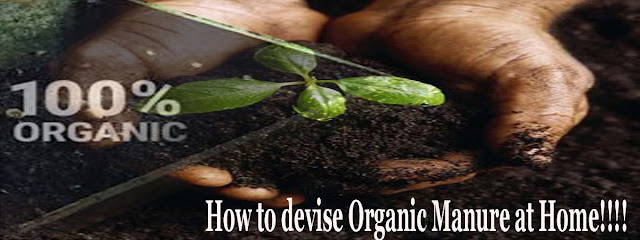How to devise Organic Manure at Home!!!
Organic manures are natural products used by farmers to offer food for crop vegetation. Organic manures are recommended within the cultivation of plants. They increase the organic subject in the soil which in flip releases the plant meals is available from the use of crops. Organic manures permit the soil to carry more water and in addition assist to fortify the drainage in clay soils. They even supply natural acids that help to dissolve soil nutrients and lead them to be had for vegetation. Organic manure is being increasingly more in style for organic farming.
Method to prepare organic manure
It is very simple to organize natural manure domestically. You can convert your day by day dustbins into wealthy, natural manure and grow plant life, vegetables, or crops with it.
So, allow us to start with the most popular approach of making ready natural manure at home-
1. Pot Composting
In this procedure, three pots are used.
1. Firstly, sort out your house chores and green waste into dry and damp in your kitchen. Leftovers of food, fruit peels, and tea luggage are damp waste while paper, plastic, and packaging house dry waste.
2. Secondly, put each of those wastes in two different packing containers in the kitchen. When the damp waste container is complete, but its contents into the primary compost pot.
3. Then add dry leaves of an identical quantity as the waste and semi-composted subject matter, buttermilk or cow dung first of all the decomposition procedure.
4. Turn the pile around each and every different day. Keep the pile on the right level of dampness. If it is too wet, upload dry leaves and stir and whether it is too dry add water and stir.
5. Once it is complete, leave the pot open for 30-45 days for the composition to happen. Then move the semi-composted topic into a bigger container or bin.
6. Later two months the waste will be transformed into wealthy compost that can be used or bought as a fertilizer...
2. Vermicomposting
It is the droppings of the worms generated after consuming the organic green waste. In this procedure, earthworms play the primary function. These worms need air, water, meals, and warmth to living and breed. By adding those worms to packing containers full of organic waste matter you'll be able to produce vermicompost.
1. Collect shredded newspaper, shredded cardboard, coconut fibers, and dry cow dung desserts.
2. Get a big plastic bath and soak these in water, squeeze out the excess water and position these materials on the backside of the trojan horse bin.
3. Next, buy or collect some earthworms from the soil they live in. Add half-done compost to this and also add green waste to this as soon as in two or 3 days.
4. Don’t feed it meat, milk products, or fatty food. Limits the usage of citrus fruits and peels to your Vermicompost bin.
5. Don’t use any acidic, persist with the end result and vegetable peel, eggshells, espresso grounds, tea bags, and tea leaves.
3. The Bokashi Method
The term Bokashi is a Japanese word that defines “fermented organic matter.” Here, this happens with a workforce of microorganisms anaerobically ferment natural waste.
a. Add daily green waste to the hermetic drum for fermentation.
b.You might see small larvas the next day to come around the rim. Then add Bokashi powder.
c.Ensure that the drum has a faucet that can drain a small quantity of the liquid generated every now and then. This liquid will odor like molasses, bran, and vinegar.
d.Around the 17th day, there will likely be some white fungus grown in the drum showing the fermentation. The white mold is a really useful fungus that is helping suppress pathogens. If you've got a white mold, it signifies that your fermentation is going neatly.
e.Collect green waste in the Bokashi drum for a month and then let it rest for 18 days.
f.Mix probably the most drum's contents with semi-done compost and put the brew in a barrel.
g.Dig a trench and then put the fermenting dump waste in it and cover it up.
h.After three-four weeks your black compost can be in a position to be served.
4. Egg Shells Dressing
You could make a slow-release calcium fertilizer by means of rinsing out the eggshells with water and drying them on a window sill to forestall them from growing mold. Once dry, grind the eggshells up in a blender or with a mortar and pestle. Store in a tumbler jar.
Eggshells include about 95% calcium carbonate which is an identical aspect as lime, a popular soil amendment used to cut back soil acidity and reinforce fertility.
However, compost ready by means of conventional methods is not well-decomposed and has poor nutrient content. Well-decomposed compost will scale back weeds and insects.
If the wastes used are not decomposed in a proper way there arises many critical insect and weed problems. The moderate nitrogen content material of the compost ready via farmers is zero.5%. Using advanced strategies can increase the nitrogen content material of the compost to at least 1.5%.
Benefits of Compost
1. Maintains soil fertility level.
2. Increases the supplements degree of the soil or give a boost to the soil's substantial condition by way of bettering soil structure and ventilation.
3. Increases the infiltration capacity of the soil, thus lowering floor runoff.
4. It helps to retain plant nutrients and moisture.
5.Well-decomposed compost buffers soil reaction and controls soil temperature.
6. It also increases soil microbial activity which is helping mineralization of implemented chemical fertilizers, making them extra to be had to plants.




Comments
Post a Comment